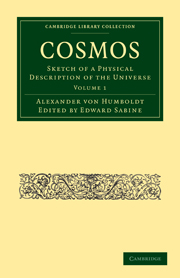Book contents
- Frontmatter
- Contents
- Title in the series
- INCITEMENTS TO THE STUDY OF NATURE: General Remarks
- HISTORY OF THE PHYSICAL CONTEMPLATION OF THE UNIVERSE
- Division into historic periods, or epochs of progress, in the generalisation of physical views
- PRINCIPAL EPOCHS IN THE HISTORY OF THE PHYSICAL CONTEMPLATION OF THE UNIVERSE
- EPOCHS IN THE HISTORY OF THE CONTEMPLATION OF THE UNIVERSE. CONQUESTS OF ALEXANDER
- EPOCHS IN THE HISTORY OF THE CONTEMPLATION OF THE UNIVERSE. EPOCH OF THE PTOLEMIES
- EPOCHS IN THE HISTORY OF THE CONTEMPLATION OF THE UNIVERSE. ROMAN EMPIRE
- EPOCHS IN THE HISTORY OF THE CONTEMPLATION OF THE UNIVERSE.—ITS ADVANCEMENT BY THE ARABIANS
- EPOCHS IN THE HISTORY OF THE CONTEMPLATION OF THE UNIVERSE.—OCEANIC DISCOVERIES
- EPOCHS IN THE HISTORY OF THE CONTEMPLATION OF THE UNIVERSE.—DISCOVERIES IN THE CELESTIAL SPACES
- RETROSPECT OF THE PRINCIPAL EPOCHS IN THE CONTEMPLATION OF THE UNIVERSE
- NOTES
- INDEX
PRINCIPAL EPOCHS IN THE HISTORY OF THE PHYSICAL CONTEMPLATION OF THE UNIVERSE
from HISTORY OF THE PHYSICAL CONTEMPLATION OF THE UNIVERSE
Published online by Cambridge University Press: 05 August 2011
- Frontmatter
- Contents
- Title in the series
- INCITEMENTS TO THE STUDY OF NATURE: General Remarks
- HISTORY OF THE PHYSICAL CONTEMPLATION OF THE UNIVERSE
- Division into historic periods, or epochs of progress, in the generalisation of physical views
- PRINCIPAL EPOCHS IN THE HISTORY OF THE PHYSICAL CONTEMPLATION OF THE UNIVERSE
- EPOCHS IN THE HISTORY OF THE CONTEMPLATION OF THE UNIVERSE. CONQUESTS OF ALEXANDER
- EPOCHS IN THE HISTORY OF THE CONTEMPLATION OF THE UNIVERSE. EPOCH OF THE PTOLEMIES
- EPOCHS IN THE HISTORY OF THE CONTEMPLATION OF THE UNIVERSE. ROMAN EMPIRE
- EPOCHS IN THE HISTORY OF THE CONTEMPLATION OF THE UNIVERSE.—ITS ADVANCEMENT BY THE ARABIANS
- EPOCHS IN THE HISTORY OF THE CONTEMPLATION OF THE UNIVERSE.—OCEANIC DISCOVERIES
- EPOCHS IN THE HISTORY OF THE CONTEMPLATION OF THE UNIVERSE.—DISCOVERIES IN THE CELESTIAL SPACES
- RETROSPECT OF THE PRINCIPAL EPOCHS IN THE CONTEMPLATION OF THE UNIVERSE
- NOTES
- INDEX
Summary
Plato describes the narrow limits of the Mediterranean in a manner quite appropriate to enlarged cosmographical views. He says, in the Phædo, “we who dwell from the Phasis to the Pillars of Hercules, inhabit only a small portion of the earth, in which we have settled round the (interior) sea, like ants or frogs around a marsh.” It is from this narrow basin, on the margin of which Egyptian, Phœnician, and Hellenic nations flourished and attained a brilliant civilisation, that the colonisation of great territories in Asia and Africa has proceeded; and that those nautical enterprises have gone forth, which have lifted the veil from the whole western hemisphere of the globe.
The present form of the Mediterranean shews traces of a former subdivision into three smaller closed basins. The Ægean portion is bounded to the south by a curved line, which, commencing at the coast of Caria in Asia Minor, is formed by the islands of Rhodes, Crete, and Cerigo, joining the Peloponnesus not far from Cape Malea. More to the west we have the Ionian Sea, or the Syrtic basin, in which Malta is situated: the western point of Sicily approaches to within forty-eight geographical miles of the African shore; and we might almost regard the sudden but transient elevation of the burning island of Ferdinandea (1831), to the southwest of the limestone rocks of Sciacca, as an effort of nature to reclose the Syrtic basin, by connecting together Cape Grantola, the Adventure bank (examined by Captain Smith), the island of Pantellaria, and the African Cape Bon,—and thus to divide it from the third, the westernmost, or Tyrrhenian basin.
- Type
- Chapter
- Information
- CosmosSketch of a Physical Description of the Universe, pp. 117 - 148Publisher: Cambridge University PressPrint publication year: 2010First published in: 1846

